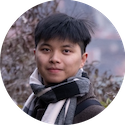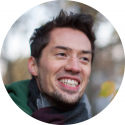Current Lab Members

Pawel has a back ground in theoretical physicist and is interested in application of statistical physics and stochastic processes to biological and ecological problems. He has worked on mathematical models of collective motion in biology, as well as related problems of pattern formation and self-propelled motion. Among other things he is currently interested in the question how collective behavior is shaped and constrained by locally available sensory information, how to determine causal information flows between individuals in animal groups, and how do animal and human groups process information in a collective way.

Yunus has a physics background and is interested in the fundamental mechanisms that give rise to emergent behavior in complex and evolving systems.
At the CIP lab and as part of a SCIoI research project, he uses computer models and field data to study self-organized criticality in animal collectives, aiming to better understand multi-agent systems like natural fish schools and their collective decision making processes. Furthermore, Yunus co-developed Utopia, a modelling framework that is designed to facilitate the implementation and analysis of models of complex and adaptive systems.

Yating has a background in engineering, computer science, and biological physics. Her research topic mainly focuses on the bio-inspired collective behavior in swarm robotics, such as bio-inspired collective motion control, i.e. flocking behavior, and task-oriented coordination, i.e. collective construction, and collective shepherding. She has worked in swarm robotic systems such as e-pucks, Stigmergic blocks, and BuilderBots. She also has research experience in developing agent-based algorithms, such as elastic models in dense active systems.
Yating is a postdoc at Humboldt-Universität zu Berlin and an integration postdoc at the Cluster Science of Intelligence (SCIoI). She is researching shepherding behavior and using a swarm robotic system of Thymio robots as a potential application platform.

Maryam Karimian received her doctoral degree in cognitive computational neuroscience from Maastricht University, the Netherlands. She has a bachelor's and master's degree in Physics from Isfahan University of Technology, Iran. During her Ph.D., Maryam focused on investigating the behavioral relevance of neural oscillations, specifically in the Gamma frequency range, and their synchronization. Additionally, she developed novel models of plasticity in large/meso-scale abstract neural networks. Her research involved employing mass neural modeling approaches and conducting psychophysics experimentation.
In 2023, Maryam started her postdoctoral research at Humboldt University, where she joined the Collective Information Processing Group and the Science of Intelligence (SCIoI) cluster of excellence. Currently, her research interests lie in studying behavioral contagion in human and artificial multi-agent systems.

Valentin is a quantitative social ethologist, with an interdisciplinary expertise on collective behaviours in animal societies. He is interested in movements and use of space in fish and ants. He did his PhD at the University of Toulouse, France and the University of Groningen, Netherlands, under the joint supervision of Guy Theraulaz and Charlotte Hemelrijk, investigating social interactions in fish schools. After a brief visit to the group of Christos Ioannou at the University of Bristol, UK, he held two postdoctoral positions in Yorkshire, first investigating the emergence of polydomous networks with Elva Robinson at the University of York, UK and studying normative models with rational agents at the University of Leeds, UK, with Richard Mann. Valentin joined the group to develop new modelling approaches involving reinforced learning algorithms for the project Evolution of collective cognition through individual-level selection.
Valentin has co-founded Animal Behaviour Live, a society promoting equity, inclusion, diversity and sustainability in the field of animal behaviour.

Mohsen received his Master’s degree in Dynamics and Control from Sharif University of Technology with a study on state estimation of nonlinear dynamic systems using a swarm-intelligence-based optimization algorithm. His research interest is mainly focused on swarm robotics, collective decision-making, as well as control theory and estimation. His focus is on bio-inspired collective decision-making methods for robot swarms. As a member of the Science of Intelligence cluster, he works on a project that aims to study the effect of the individual modulations on the collective behavior, in general, and the effect of such adaptations on the collective speed-vs-accuracy trade-offs, in particular.

I am Clémence, a PhD student with a background in computational/cognitive science and philosophy. Currently, I am affiliated with Humboldt Universität and Einstein Center for Neurosciences in Berlin, and my research is supervised by Pawel Romanczuk and Wolfram Barfuss (University of Bonn). As part of my PhD, I am investigating the impact of cognitive biases on collective decision-making in fluctuating environments. In particular, I am interested in the influence of optimistic vs. pessimistic decision-making on cooperation in the face of climate change. To inquire about these topics, I use tools from computational neuroscience and complex systems science, such as (distributional) reinforcement learning and agent-based models. In my free time, I like hiking, listening to jazz and folk music, and writing fiction.

David is a pre-doctoral researcher at the CIP group and the Science of Intelligence Cluster and has a background in Computational Neuroscience (M.Sc.) and Molecular Bionics Engineering (B.Sc.). In his Master’s thesis he showed that bio-inspired, fully vision-based flocking algorithms can serve as robot controllers in mobile robots to produce dynamic collective movement similar to those observed in natural groups (e.g. fish, birds). His research focuses on modelling collective behavior, including collective movement and collective foraging, engineering collective movement behavior on a robot swarm and building an augmented reality setup for simulated agents, humans and robots.

From a chemical engineering undergraduate degree, to a biophysics/biochemistry MSc at KU Leuven with a thesis on a reaction-diffusion-localization system as well as a publication for an ant-based simulation of collective cooperation (https://pgovoni21.github.io/), Patrick has migrated to the multidisciplinary field of vision-based navigation, joining the CIP lab via a self-secured grant from the Elsa-Neumann-Stipendium.
Through evolving neural network controlled agents embodied in minimal simulated environments, Patrick is exploring tradeoffs among visual input qualities used to construct effective & reliable navigational strategies: between angle and distance information at the individual spatial level, and between individual and social information at the collective level.
Outside of the lab, Patrick enjoys cooking spicy dishes, climbing plastic rocks, and whistling funky rhythms.

Valerii first studied clinical psychology and then completed a master's degree in cognitive neuroscience. Before joining SCIoI, Valerii worked as a research assistant at the Social Intelligence Lab at the Humboldt University in Berlin and later at the Center for Humans & Machines at the Max Planck Institute for Human Development. There he focused on the development of behavioral experiments, both online and in virtual reality.
At SCIoI, Valerii is currently working on the synthetic aspect of Project 51, "Navigating the explore-exploit trade-off in collective search". In this project, he is investigating how two collectives with different goals engage in collective search and avoidance strategies.

Fabio is a master student in biophysics at the HU Berlin. Within the group he did his study project and bachelor thesis. The topic of his work was the information propagation in weighted visual networks with the escape response of a fish swarm as underlying experimental setup. Currently, he is working as a student assistant together with Maryam Karimian and Anant Kulkarni on behavioral contagion in human and artificial multi-agent systems with visibility of agents as determining factor for their social influence.

Debapratim is a current master's student of computational neuroscience at BCCN & TU Berlin. With training in theoretical physics and mathematics from Oxford University, he worked on quantum computing and cryptography in Singapore before switching to computational neuroscience. He has worked on metacognition (work with Filevich lab), thalamocortical dynamics and psychedelics at the Larkum lab where he is writing his masters thesis. Debapratim is interested in emergent phenomenon and phase transitions which brought him to the group to work on many agents modelling of collective resource tracking.





Current Visitors

I am pursuing my Bachelor's degree in Artificial Intelligence and Decision Making as well as Philosophy at MIT. Outside of that, I am interested in Ancient and Medieval Studies and Cognitive Science. I am working on modeling distributed collective shepherding algorithms with Yating this summer, applying some techniques I have learned from my research back home with the MIT Energy-Efficient Multimedia Systems lab, modeling data movement on computer chips.
Outside of academia, I am a part of MIT Motorsports, where I develop firmware for our formula-style car for the Formula Student competition. I primarily work on our sensor suite, trying to provide precise data to our controls and validation teams to ensure we get the most performance out of our car.
Former Members & Visitors

Palina is a computer mathematician and a computer scientist with a special interest in studying collective behaviour (swarm intelligence) of biological and artificial systems. In her PhD, she focused on the development of decentralised collective decision-making algorithms with a particular focus on the individual cognition (in terms of preferences, opinions, and beliefs of an artificial agent) in the group and the impact of the environment on the self-organised consensus process. As a member of the SCIoI cluster, she works in collaboration with the team of biologists to understand the biological mechanisms underlying the predator-prey interactions in group hunting behaviour by means of mathematical and computational modelling.

Wenhan is currently pursuing a PhD degree in Control Science and Engineering with the Department of Automation, Tsinghua University, Beijing, China. His PhD project involves crowd evacuation, pedestrian group, collective behavior, network science, and decision making. From April 2023 - April 2024, he joined our group as a visiting PhD student for one year, working under the supervision of Prof. Pawel Romanczuk. During this time, he worked on studying the behavioral contagion of fish groups during startle cascades. In particular, he constructed a coupling model of movement and propagation to explore the impact of dynamic characteristics on the cascade size of fish groups. He is interested in a wide range of social and biological systems, from bacterial communities to human groups, including flocks of insects, birds, fish, and mammals, with a particular focus on the collective behaviors originating from local interactions between individuals, and a desire to understand the mechanisms behind the coordinated movements of animal groups.

I’m a Student of Physics of complex systems in Italy. I’m writing my thesis on the study of self-organized criticality in animal collectives. Specifically, I’m modeling the naturally occurring behavior in freshwater fish Poecilia sulphuraria; these fish perform collective and synchronised diving as a response to bird attacks, generating wave-like patterns on the water surface.
In my free time, I like to take pictures, read, sew and watch movies.

Luis did his PhD in physics at the University of Nice, in France. He has been working on modelling collective behavior in multi-agent biological systems at different scales (from microscopical bacterial systems up to macroscopical herds of sheep), where he aims to understand the emergent phenomenologies observed in these natural systems. He has experience on planning/performing experiments, as well as in proposing and studying theoretical models and implementing numerical simulations (mainly in C++ and Python). In our lab he was studying highly synchronized diving behavior in dense fish schools, characterizing the information spread within the group, as well as the critical properties of the system. After leaving our group he moved on to a postdoctoral position in Paris/France.

Winnie is currently studying fundamental properties of visual networks and complex contagion with applications to collective behavior of locusts and fish. She has a background in theoretical physics and has previously studied the formation of patterns on networks of nonlinear oscillators. More specifically, she focused on the influence of the network topology on pattern formation. She has a broad interest in dynamic processes on networks, such as the spreading of information or diseases, and was already engaged in research of social influence in human groups as a student assistant.

Pascal plans to work on modeling collective response to threats, and analysis of causal information flows in fish schools. He has a background in data analysis, anticipation or prediction of tipping points and in opinion dynamics on time evolving networks. The latter involved studies in which zealots where introduced, whose opinion can not be altered by other agents. Specifically the spreading of their opinion in dependence on their degree was of interest.

Yinong is a former PhD student. He did his undergraduate has a background in mathematics and applied mathematics and did his Master in System Theory at the Beijing Normal University. His primary interest during the time in our lab were fundamental aspects of complex systems with a particular focus on emergence and stability of collective states. In his PhD he explored the ability to distinguish distinguish different types of (social) interaction, both leading to emergence of collective motion at large scales, through observations of the collective dynamics of corresponding agent-based models, as well as the coupling of collective movement with contagion models.

Fritz is a former PhD student. He gained most of his academic training in classical biology while transitioning through the fields of marine biology and ethology. He has been working on social interactions and collective behavior in fish, both in controlled lab situations and under natural conditions in the field.
His PhD project was in close collaboration with David Bierbach at the Humbold University, as part of the interdisciplinary Science of Intelligence Excellence Cluster. It focused on collective learning and information processing in multi-agent systems. More specifically, Fritz researched processes by which information is acquired, shared and applied, scaling from the individual to the collective. After his PhD he joined the lab of Albert Kao in Boston/USA.

Andreu is pursuing his Ph.D. at Universitat Politècnica de Catalunya (Spain) under the supervision of Prof. Romualdo Pastor-Satorras. His research focuses on studying information transfer and interaction signatures in experimental data of schooling fish, utilizing techniques from statistical physics and agent-based modelling.



Kai Winkler was a master student in biophysics at Humboldt Universität zu Berlin. In our lab he worked on his student project and his master thesis. The topic of his work was on the evolution of social strategies in agent-based models, and in particular the role of the landscape topology and agent motility.

Janosch was a student in the biophysics master program at the Humboldt Universität zu Berlin. His study project and his master project investigated the self-organized evolution of distributed transport networks inspired by the slime mold Physarum polycephalum.

Linda was a M.Sc. Biophysics student at Humboldt University of Berlin. In her master she worked on an agent-based model with heterogeneous speeds to investigate the role of individual speed in collective dynamics.

Saskia was a graduate student in biophysics. Her study project and master thesis investigated various aspects of evolutionary dynamics and collective information processing in agent-based flocking models.

Rachith did his Bachelor's in Mechanical Engineering and Master's in Physics at BITS-Pilani, India. During his final semester, he visited the Romanczuk lab to pursue his master's thesis between January - May 2019. During this time, following his interest in collective behaviour and complex systems, he worked on modelling collective information cascades in adaptive networks. Particularly, he aimed at building a model which couples the dynamics on the network with the dynamics of the network topology. To model the former, he drew motivation from the Dodds-Watts model of contagion and the LIF model of neuronal dynamics. To model the latter, he drew motivation from the startling cascades commonly observed in biological systems such as fish schools.

Mariya joined us from University of Pittsburgh as a RISE intern in our lab, In her project, she worked with Winnie on developing a visual interaction model combining structure adaptation of fish schools together with cascading complex contagion process (startle cascades).


Andrej has a background in computer science and computational neuroscience. He did his his Master project in our lab, within the Computation Neuroscience Master program at the Bernstein Center for Computational Neuroscience. In his thesis he developed and analyzed a neuronal model for startle response in schooling fish.

Claudia was a graduate student at the Bernstein Computational Neuroscience Master program. As an undergraduate she studied Applied Mathematics and Philosophy at the TU Wien. Her thesis project was on agent-based models of collective decision making and the wisdom of crowds with unreliable and correlated information cues.

Stephan studied physics at the Humboldt Universität zu Berlin. In his master thesis project in our lab, he worked on mathematical models of Placozoa (Trichoplax Adhaerens), one of the simplest multicellular animals. Here, he explored how these fascinating, yet little known, animals are able coordinate their motion and explore their environment effectively despite lacking a central nervous system and any apparent hierarchical body plan.


Carsten worked as an undergraduate in Biophysics at the HU between September 2018 and March 2019 on his student research project and his bachelor thesis project in our lab. In his study project he worked on quantitative analysis of large-scale startle wave propagation in video recordings performed during our field research in Mexico, while in his thesis project he implemented and analyzed an evolutionary model for collective predator response motivated by the Mexico field system.

Franziska was an undergraduate in Biology at the Humboldt University. In our lab she works on her student research project and bachelor thesis on modeling and simulating the leadership experiments performed at the Robofish Lab using individual-based models of social behavior.


Bugra was an research intern in our lab up to September 2018. He just graduated from the Istanbul Technical University in Electrical and Communication Engineering, and works in our group on emergent dynamics in agent-based models of consensus formation.

Parisa was a visiting PhD student from the Institute for Advanced Studies in Basic Sciences (IASBS) Zanjan, Iran. Her broad interests are soft condensed matter physics, biophysics, statistical physics, computational physics,
and complex systems. She was visiting our lab between June 2017 and June 2018, where she worked with Pawel Romanczuk on the role of different interaction networks on collective behavior of self-propelled agents in heterogeneous environments and in the presence of informed individuals.

Olenka is an undergraduate student in physics at Harvard University. Between June and August 2018, she was as a research intern in our lab through the DAAD RISE Program. During her internship she worked mainly with Pascal Klamser on coarse-grained mathematical description of the escape response in large fish schools.

Conor, a physics undergraduate from University of St Andrews (Scotland), spent three months in our lab during summer 2017 as a research intern (RISE program / DAAD) working with Pascal Klamser and Pawel Romanczuk. Conor worked on a project involving using a convolutional neural network to detect fish in complex video data from our field research in Mexico. In particular, he wrote a program that takes the fish object detected by the neural network and connects individuals across frames in the video. Conor was able to achieve a significant improvement of the fish detection by reducing false positive detection via filtering the neural network output based on the length of trajectories obtained from this chaining process.

Rachana visited us in June/July 2016 just after her first year in computer science at Princeton University. During her internship she worked for 6 weeks on analysis of video data of fright waves in dense fish schools, recorded during our 2016 field trip to Mexico in collaboration with colleagues from Berlin, Princeton and Konstanz.

Ishan worked in our group in May/June 2016 just after finishing his first year studying Mathematics at Princeton University. He worked with Pawel Romanczuk for 6 weeks on collective information processing in agent-based models of flocking. More specifically he studied the response of a flock to a predator agent using computer simulations.

Clark visited our lab in June/July 2017 as an architecture undergraduate at Princeton University. He explored during his internship the modeling of complex systems with Python. In particular, he analyzed an cellular automata model of an excitable system as a coarse-grained model for spreading of startling response cascades and sustained startling waves in large-scale, high-density fish populations.